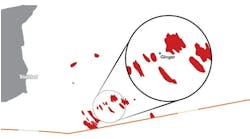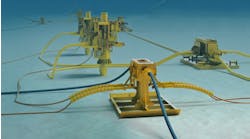Dual-stage cyclone separator readied for trial
- Typical single-stage, push through separator developed in the early 1990s. [48,251 bytes]
- When applying a DOWS for a fixed water cut of 60%, as the graph shows, in a prolific reservoir, a production increase of 100% can be achieved. [35,800 bytes]
Now, the technology is being re-formulated for offshore use, but with more wide-ranging goals - combining high flow rate (around 20,000 b/d) with low water cut (above 50%). This technology requires the use of a dual-stage, hydrocyclone separator, a prototype of which recently underwent laboratory tests. Funding has been supplied by ten producers in readiness for a first field trial later this year.
Gunder Homstvedt of Kværner and Tim Collen of REDA outlined progress to date in a paper at the 10th Underwater Technology Conference in Bergen in March. The transfer of traditional processing activities from platform topsides to a downhole setting will accelerate in time, they said, to encompass handling of scaling, de-gassing and sand removal. But for now, the key downhole processing activity remains the removal of production water.
On numerous North Sea oil wells in particular, handling produced water has become increasingly problematic. Water cut gallops to a point where it threatens to outstrip the platform's handling capacity. That can force premature shut-in of certain productive oil wells, just to keep even more prolific wells onstream.
A novel approach, according to the authors, "is to remove most of this water close to the reservoir. The conditions for removing water are quite favorable - at relatively high temperatures, the fluid viscosity is low and gases and asphaltenes are still in solution. Oil coming from the reservoir is not yet sheared or mixed by any mechanical device, making big drops that are easy to separate.
"By removing most of the water early in the flow path, the pressure drop in the production tubing is reduced due to less head. This could allow for increased production. The reduced amount of water also minimizes the need for chemicals for water treatment... [while]... reservoir pressure can be maintained by reinjecting the water and the process also takes care of the problem of water discharge at the surface.
"Downhole injection might, however, be one of the biggest challenges in this undertaking. Gradual build-up of injection reservoir surface skin by carry-over oil, scaling, and sand might represent a threat to injectivity in time." Also, injection above the fracture pressure might demand power pumps too bulky for such a confined space.
The oil/water separation method developed by Kværner and REDA is based on hydrocyclones. On the plus side, these conical tubed structures adapt well to downhole application being robust, passive devices. However, their operating envelope and capacity are limited typically to up to 250 cu meters/day for de-oiling with an underflow oil-in-water content of 200-500 ppm.
For hydrocyclones to perform successfully in removing and cleaning water from a flow stream with a high oil content, the solution may be to install two cyclones in series. The first would remove the bulk of the oil while the second would clean up the water (a pre-de-oiler cyclone). Multiple cyclones could be stationed downhole to achieve the desired flow capacity. But the dual-stage separators would be best suited to the lower range water cuts of around 50%.
Single-stage, hydrocyclone-based downhole separators, which can be used for high-end water cuts of 85%-plus, were first proven in field installations in 1994, made and marketed under the REDA trade name of Aquanot. Thirty-nine Aquanot DOWS installations have been made on 17 wells, with 590 days being the longest continuous run life achieved (by the end of March).
Driving each DOWS single-stage separation unit is a motor and two ESPs, one to thrust reservoir fluids through the separator and create injection pressure, while the other provides lift for the oil to get to the surface. Flow rates of these relatively low-temperature, high WOR wells (all land-based) are typically up to 7,000 b/d.
In each case, installation of the DOWS decreased the WOR (water/oil ratio) considerably, the authors claimed, as well as increasing surface oil production. As for system failures, the most common cause - nearly one-third - was damage to the injection zone caused by solids or emulsion production, not helped by inaccurate injectivity data presented during the design stage. This led to the design of the separator system being off target, reducing efficiency of the separation from the wellstream.
For the current offshore R & D, the sponsors are BP, Chevron, Elf, PanCanadian, Phillips, Saga, Shell, Statoil, Texaco, and Total. Phase 1 work comprised evaluation of a single-stage separation unit for offshore use, a system study of a dual-stage tool, and the construction of a prototype. Recent laboratory tests were staged to determine the performance capabilities of a dual-stage system and the associated instrumentation and control strategies for varying well conditions.
To further assess the tool's potential, a simulation study was executed based on data from a high output North Sea well, measuring normal performance with and without a DOWS unit. With artificial lift assumed to be unnecessary, the DOWS consisted only of a separator and an injection pump.
Reservoir and wellhead pressure was maintained as constant. According to the authors, a 60% oil production increase results when applying a DOWS for water cut in the range 40-60%. The increase is less for higher water cuts. For a very prolific reservoir, they claim that a downhole separator can actually double production, based on their simulations.
Following three years of field results from onshore wells, the aim is to achieve first offshore implementation of a downhole separation tool within the next two years, but suited to a wider range of water cuts, and installable earlier in the well's life cycle.
Copyright 1998 Oil & Gas Journal. All Rights Reserved.


